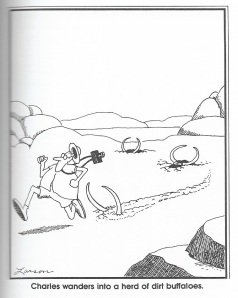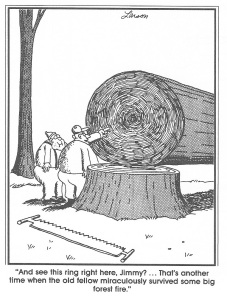An example of the inversion of reality in comics is The Far Side by Gary Larson. His comics are often one frame, usually with a caption or speech bubble which enables the reader to get the point very quickly. Gary Larson delves into a distorted reality that utilizes common people, animals, and situations, and re-contextualizes them in a humorous way. For example, a single frame shows a man running away from a set of horns moving through the ground. The caption says, “Charles wanders into a herd of dirt buffaloes.” The dirt buffalo is a play on the water buffalo. The thought of a water buffalo does not inspire laughter, but when the basis of the name is switched, the idea of a dirt buffalo is pretty ridiculous.
The title of the cartoon series helps elucidate the theme of the jokes by asking the audience to use their imagination and stretch it to a new place. The far side of what? The far side of reality. The term “the far side” can be used to denote something that is unknown. Like Rod Serling, Gary Larson uses the template of a new place and injects it with real themes.
Ayelet Kohn described the way cartoons can be used as a successful medium for satire, inherently providing an environment for deformed reality. She claims, “The ludicrous and comic foundations are what give satire its unique character, in the light of which the gap between the theory and the practice is revealed. “ Much like the way satire existed in the realm between the Twilight Zone and reality, cartoons allow an area of separation from reality and criticism. The cartoons prepare the reader for a situation that is not quite real, the caption often roots the reader to a real-world concept, and the anthropomorphism, or tweak in reality, makes the reader wonder what it is that the comic is satirizing.
In an example of satire, Gary Larson criticizes the destruction-laden nature of humans. A father and son stand next to a tree that they had just cut down, and the father says “And see this ring right here, Jimmy?…That’s another time when the old fellow miraculously survived some big forest fire.” When viewed individually, the caption and the picture portray two opposing ideas. The quote suggests an attempt at marveling nature; the picture suggests that the two are merely bonding over an activity. The disconnect between the picture and the caption provide the satire. In order to adequately appreciate the beauty of the tree, it must ironically be destroyed.

